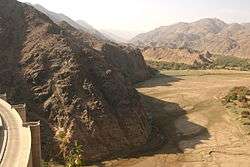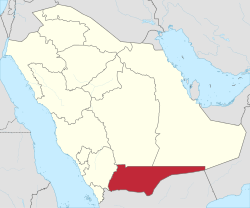Najran Region
| Najran | |
|---|---|
| Region | |
| منطقة نجران | |
 | |
 Map of Saudi Arabia with Najran highlighted | |
| Capital | Najran |
| Boroughs | 8 |
| Government | |
| • Governor | Jelawi bin Abdulaziz bin Musaed bin Jelawi Al Saud [1] |
| Area | |
| • Total | 149,511 km2 (57,727 sq mi) |
| Population (2010 census) | |
| • Total | 505,652 |
| • Density | 3.4/km2 (8.8/sq mi) |
| ISO 3166-2 | 10 |
Najran (Arabic: نجران Naǧrān) is a region of Saudi Arabia, located in the south of the country along the border with Yemen. It has an area of 149,511 km². Its capital is Najran.
Najran is inhabited by the powerful Yam tribe, who have lived in the region for hundreds of years.
Mishaal bin Abdullah was the governor from 2009 to 22 December 2013. The former governor was Mishaal bin Saud but he was relieved in 2008.[2] This move was closely related to the region's unique characteristics since the majority of people in this region are Shia Ismaili. 400,000 Ismailis reside in the region.[3] The current governor of the region is Prince Jalawi Bin Abdul-Aziz Bin Mosaad.
Etymology
The name of Najran means "the piece of wood in which the hinge of the door goes around". The word "Najran" also means thirsty. Another explanation is that the name was attributed to Najran Ibn Zaidan Ibn Sabaa Ibn Yashgab Ibn Yareb Ibn Qahtan because he was the first person to come to Najran and inhabit it.
Geography
Najran contains three geographical areas. First, the flat area which lies in the middle of Najran. It has several valleys, the most famous of them being Najran’s valley. Second, the mountainous area which is in the west and the north. There the weather is moderate in summer. It has several beautiful parks shaded by nabk trees. It has important governorate centers: Habuna governorate, Badr El-Junoob governorate and Yadmah governorate; the latter governorate won King Fahd’s attention because it has mineral wealth. The most important of all is the gold area where much gold was mined that lies in El-Johns area, which follows Safah center. Many of the mountains are distinguished by granite rocks, where marble and granite are quarried, providing a large part of the Kingdom’s needs. Third, the sandy area which lies in the east and is a part of the Empty Quarter. It is extremely rich in oil.
Governorates
- Al Khirkhir (4,015)
- Badr Al Janub (11,117)
- Hubuna (20,400)
- Khubash (22,133)
- Najran (329,112)
- Sharurah (85,977)
- Thar (16,047)
- Yadamah (16,851)
Najran valley dam
Najran Valley Dam is considered to be one of the most important civil places in Najran Region because of its special position and its beautiful scenery. It is 35 km from Najran town. On this dam, there is a road 4.5 meters wide. It was built from concrete blocks, and has a system of water pipes which keeps the water cold.
As-Saud Waterfall
As-Saud Waterfall is one of the most beautiful places in Najran, and can be seen from a considerable distance away.
Governors of Najran
- Mishaal bin Saud 1997–2008
- Mishaal bin Abdullah Al Saud 2009–2013
- Jalawi Bin Abdul-Aziz Bin Mosaad 2013-
Religious groups in Najran
Najran, a fertile valley in what is now southwestern Saudi Arabia at the foot of mountains bordering the vast stretch of desert known as the Empty Quarter, was traditionally home to Christian and Jewish communities, in addition to Sulaymani Ismailis and Zaidis. Christians have been absent from Najran for some centuries, and the remaining Jewish community is believed to have left in 1949, following the establishment of the state of Israel. Najran's Zaidi community in 2008 numbers around 2,000.[4]
The 2004 Saudi census puts the number of inhabitants in Najran at around 408,000. Sulaymani Ismailis, widely believed to constitute a large majority of the Najrani population, share a homogeneous identity based on historical, cultural, and religious roots. In Najran city, the Khushaiwa compound, with its Mansura mosque complex, is the spiritual capital of the Sulaymani branch of the Ismaili sect, one of two major strands of contemporary Ismailism. Ismailis in Najran belong mainly to one of two tribes: Yam and the Hamdan. These tribes extend into territory that today lies in Yemen. There are also some Sunnis of the Yam tribe, both recent converts and adherents to Sunni Islam for generations.[4]
Ancient Christian community
Najran is known for an ancient settlement of Christians in the Arabian peninsula. They signed the Najran Pact in the 7th century with the Islamic prophet, Muhammad, promising them fair treatment as 'protected' subjects (dhimmi) of the newly conquered territories. The village is now abandoned.[5]
Culture
Cuisine
The most famous dishes in Najran include:
- Al-Burr: a breakfast meal which consists of bread made from wheat and flour, it is mixed and given the round ball shape and a hole is made to put milk, or honey, or dates honey on it,
- Al-Wafed: a thick kind of bread made of wheat and is also made in round shape, it is served in Al-Matrah beside Al-Marg,
- Al-Maasooba: made of corn flour meshed and some soup added is to make it soft, and it is usually served in a special ceremonies,
- Ar-Ruksh: a soft kind of bread which comes in the shape of slice and it is served in the pot made of stone and then it is mixed with the soup,
- Al-Margoog: consists of dough which is cut into small slices and it is cooked with soup and vegetables.
Folk arts
Najran has some folk arts including the traditional clay considered to be among the most beautiful in Arab area. The houses are built of light tan clay in the shape of a rectangle. On the other hand, Najran has different kinds of traditional dance. For example, Al-Zamil which is an enthusiastic kind of poetry refers to special occasion in which so many men share together in the middle of a circle formed by old men. The stanzas of Al-Zamil are chosen carefully to express the subject for the occasion. Furthermore, Al-Zamil is considered to express emotions, and some time for apologies. Al-Razffah describes a dance which is used for wedding, or for happy occasions. Choirs come into rows and they sing poetry, and their country’s glory they are usually they for beautiful girls, and for the emotions. Al-Razffah has a special time and special voice. Between the two rows two men meet each other and they dance in specific movements holding stilettos or sticks in their hands. Also there is another art that is (Laa'bat Ateran) done by black men.
See also
References
- ↑ http://www.e-najran.gov.sa/English/News/Pages/nwz1013.aspx
- ↑ http://www.kkh.med.sa/Portal/en/news-a-event/70-2010-03-18-00-20-19.html
- ↑ Ana Echagüe; Edward Burke (June 2009). "'Strong Foundations'? The Imperative for Reform in Saudi Arabia" (PDF). FRIDE (Spanish Think-tank organization). pp. 1–23. Retrieved 15 April 2012.
- 1 2 "The Ismailis of Najran" (PDF). Human Rights Watch. September 2008. Retrieved 16 April 2012.
- ↑ Frankfurter, David (1998). Pilgrimage and holy space in late antique Egypt. BRILL. p. 388. ISBN 978-9004111271.
- Minosa, Tchekof. Najran: Desert Garden of Arabia. Paris: Scorpio Editer, n.d
External links
| Wikimedia Commons has media related to Najran Province. |
- Travel through the province of Najran, Splendid Arabia: A travel site with photos and routes
 |
Riyadh Region |  | ||
| Asir Region | |
Eastern Region | ||
| ||||
| | ||||
| |
|
|
Coordinates: 17°29′30″N 44°07′56″E / 17.49167°N 44.13222°E
